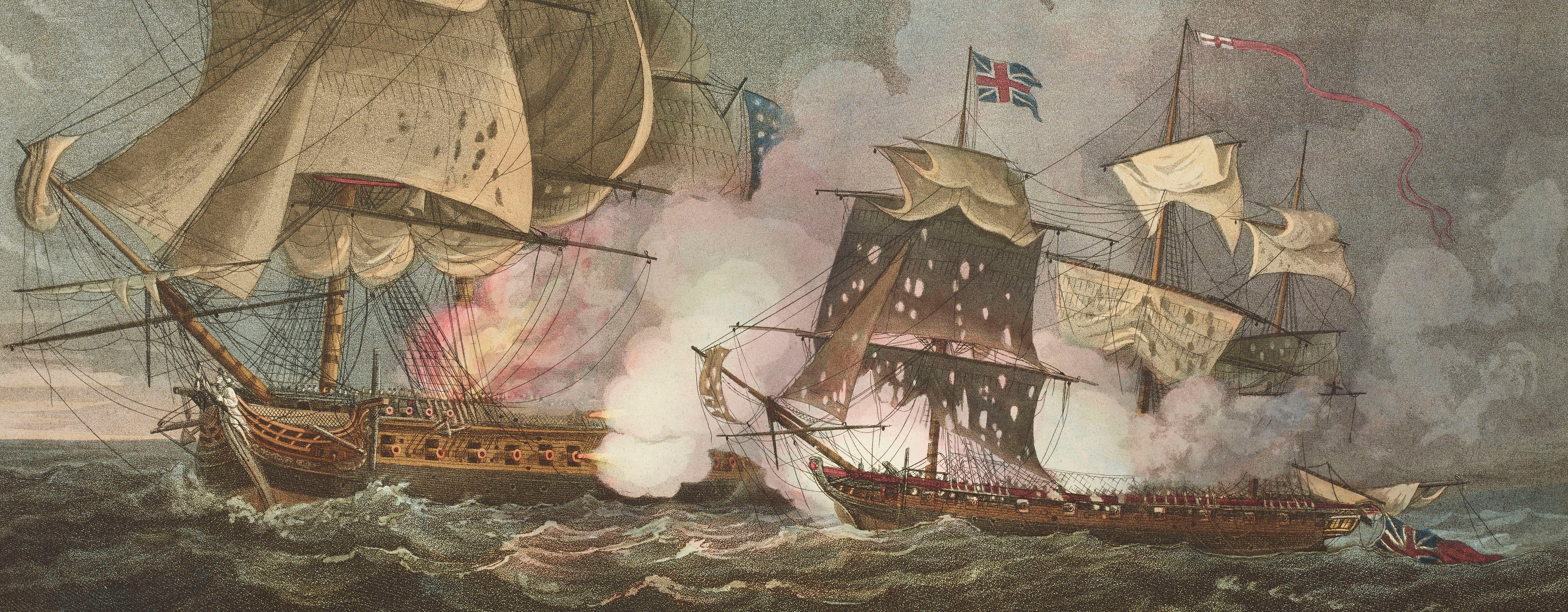
Other 18th-/19th-century conflicts
Maps, views and documents from 19 wars
View of the Battle of Fort Oswego, 1814 (Fort Oswego [also known as Fort Chouaguen], New York, USA) 43°27'41'N 76°30'52'W
published 1 May 1815Aquatint with etching and engraving; printed on paper; hand coloured; edged with paper | 43.6 x 53.6 cm (image) | RCIN 735185.4.b
Yeo had been appointed commodore and commander-in-chief of the warships on the North American lakes on 19 March 1813. He had built two large ships during 1813-14 and these, together with the rest of his squadron (seen in the foreground of this view), were used to carry a large number of troops to attack Fort Oswego in early May 1814.
Fort Oswego, seen in the centre of this view, flying the American flag (which is not drawn with any pretence at accuracy as to the number of stars and stripes) was not the strong structure it had been during the French and Indian War of 1754-63. Although, in 1814, was an important staging post on the American supply route from New York, its defences had crumbled, and its guns were damaged. Nevertheless, the Americans put up a strong resistance and can be seen here, in a line on the slope below the fort, firing at the British troops which had just landed.
One of a pair of views; the companion print is at RCIN 735185.4.a.
Additional text: [bottom, along edge of view, notes identifying the main features in the view.]
For further reading, see:
J.K. Laughton, 'Yeo, Sir James Lucas (1782–1818)', Dictionary of National Biography, 2004; online edition 2008.
Condition: one faint fold line. Verso: slight surface dirt.
Robert Havell (1769-1832) (engraver) [bottom right, below edge of view:] Engraved by R, Havell; [bottom centre, below title:] London, Published May 1, 1815.
[John] Hewitt (active 1814) (artist) [bottom left, below edge of view:] Drawn by I, Hewett, Lieut,t Royal Marines.
Subject(s)
Army-USAArmy-GBWatermark: J WHATMAN / 1813
Condition: one faint fold line. Verso: slight surface dirt
38.9 x 53.6 cm (neatline)
43.6 x 53.6 cm (image)
47.5 x 60.6 cm (platemark)
50.8 x 63.8 cm (sheet)
Printed title:
STORMING FORT OSWEGO, by 2.nd Battalion ROYAL MARINES and a party of SEAMEN; 15.m past Twelve at Noon. [bottom, below view]
Printed title:
Plate 2. [bottom right, above platemark]
Additional text:
[bottom, along edge of view, notes identifying the main features in the view.]
Annotations:
(Recto) [bottom left, black pencil, in Evelyn Heaton-Smith's hand:] G3. XV-185-4.b.; (Verso) [bottom left, black pencil, in Evelyn Heaton-Smith's hand:] 237.a.(ii); [top right, black pencil, partly obscured by edging:] 33; [centre, black pencil:] 33.
George III catalogue entry:
Oswego Two Views of the Attack and Storming of Fort Oswego on Lake Ontario by the 2.d Battalion of Royal Marines and a party of Seamen, on the 6.th of May 1814: by Lieut. Hewett, engraved by R. Havell, 1815.
Subject(s)
Fort Oswego [also known as Fort Chouaguen], New York, USA (43°27'41'N 76°30'52'W)
Bibliographic reference(s)
C. de W. Crookshank, Prints of British Military Operations: a cat. raisonné with historical descriptions covering the period from...Abyssinia, London, 1921. no.37:3, p.55. Crookshank notes that these prints were published by Havell, but there is no evidence on the print itself, other than to state that Havell was the engraver, to indicate this
J.K. Laughton, 'Yeo, Sir James Lucas (1782–1818)', Dictionary of National Biography, 2004; online edition 2008.
H. Parker, Naval battles from the collection of prints formed and owned by Commander Sir Charles Leopold Cust, With an introduction by C.N. Robinson, London, 1911, no.237.a
Page revisions
5 June 2024
Current version






